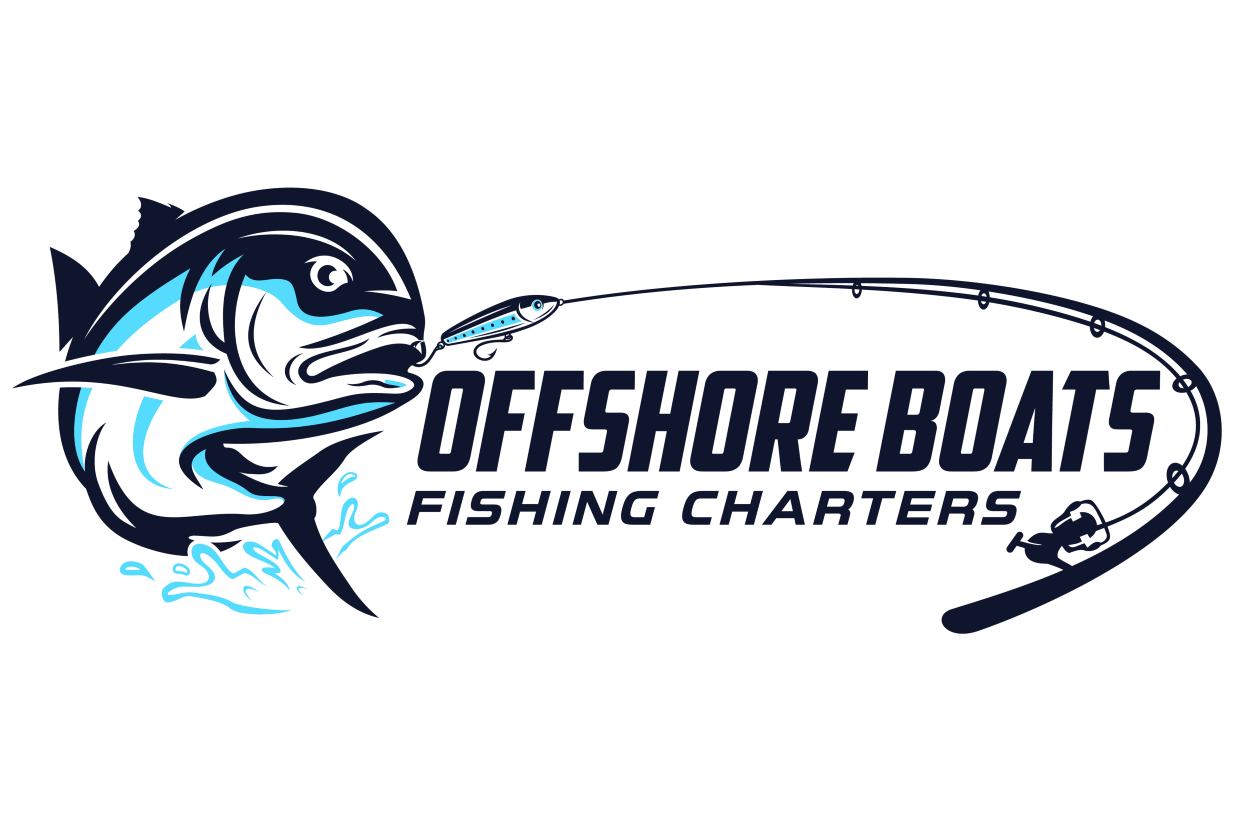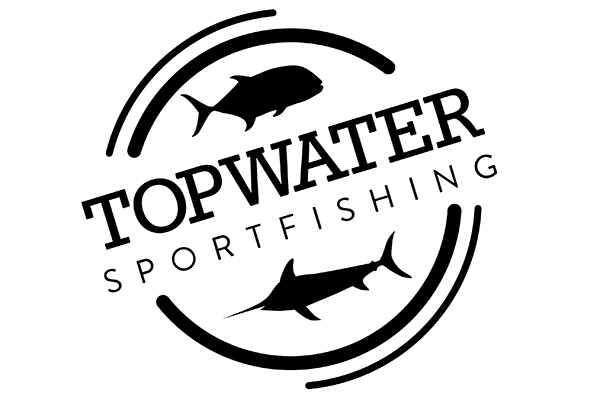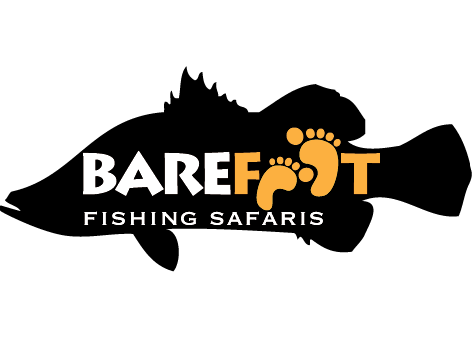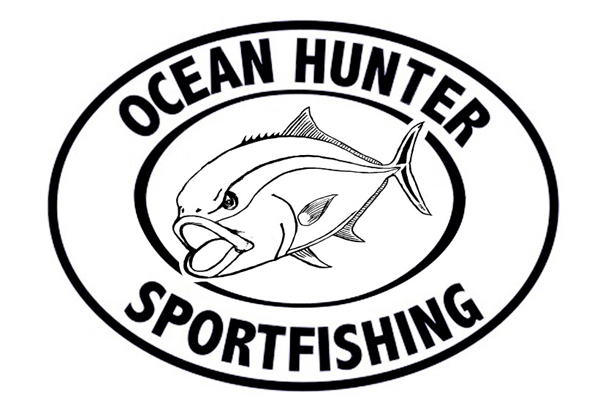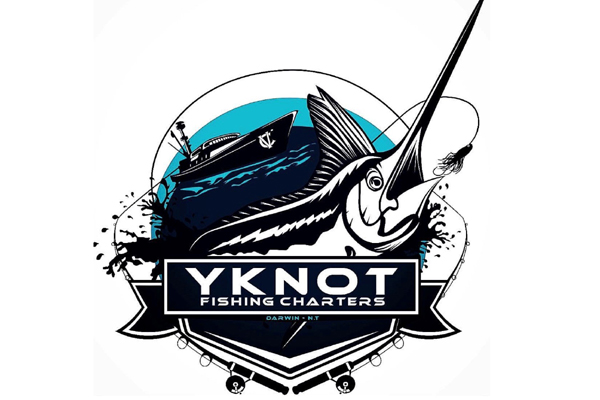How many keen anglers dream about remote destinations, awesome fishing, amazing scenery and adventure? If this is you, the mere mention of “the Kimberley” conjures up iconic images of wild Australia – ancient landscapes of red cliffs, iridescent blue water and most importantly – amazing fishing.
Yet for many, the idea of an epic Kimberley adventure is an unfulfilled dream. The distances, fishing gear, boat requirements, cost and for some, the confidence to give it a crack, can all be hard to sort through. If you are like me and lay awake at night dreaming about experiencing places like the Kimberley under your own steam, but don’t know where to start, then this article is for you.
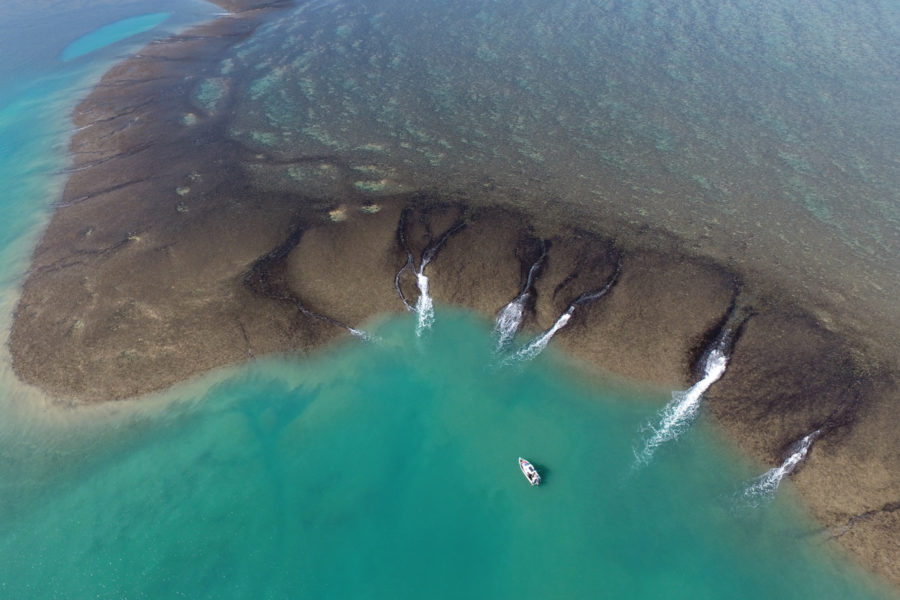
I’m no expert but I have visited a few times now, and have generally worked it out for myself, with generous insight provided by friendly locals. This isn’t a technical article, just real-world tales from experience that might help you plan your own epic Kimberley adventure.
To boat or not to boat?
Do you have a suitable boat? Your boat needs to be extremely reliable. In most cases, you will be a long way from help if you get in a jam. The second question is, what species do you plan to tackle? Do you plan to target rivers only, or do you have aspirations to get into the iconic blue waters of the Kimberley coast?
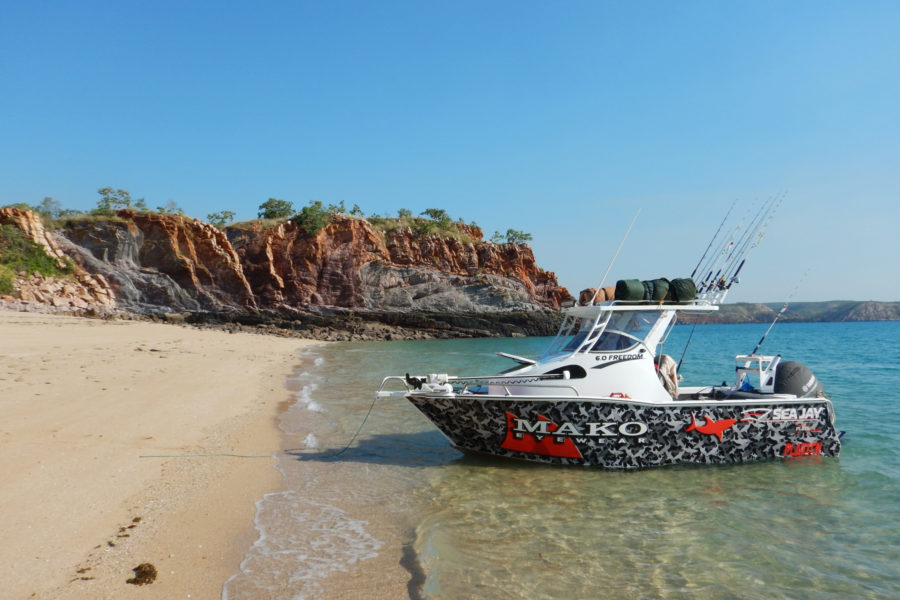
This article is focused on longer range Kimberly coast exploring and overnight boat or beach camping. All from a trailer-able boat, in a size that is achievable with some hard work, or sharing the cost with a few mates.
Fuel range, weight and treacherous waters are the key challenges. Due to the number of islands and bays to hide amongst, the Kimberley tends not to experience large swell, but it can have nasty wind-blown chop. When this chop combines with the effect of tidal movements, upwards of 10 meters at times, you can experience some testing moments. My boat is a SeaJay 6m Freedom plate ally boat. I have the walkaround deck layout. This gives shelter when the weather turns foul, but still allows access around the boat.
Shelter is crucial and if you plan to camp on the boat, 6m is around the minimum. At 6m, you can punch through the nasty stuff when needed, have just enough room to stow gear for two people and can still sneak up most rivers and creeks.
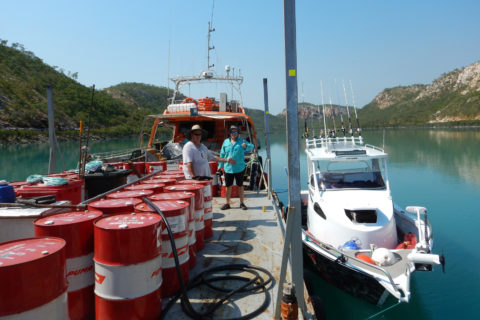 In terms of fuel range, a rule of thumb is 1:1, 1km travelled per litre. To this, you need to add a safety margin and work out where you are planning to go. In my case, real world consumption on long range trips (for a 175hp Yamaha four stroke) ranges from 0.9km/L to 1.3km/L. Currents, wind, weight and speed effect this significantly. My Yamaha has smart gages showing me real time consumption. In my case, the boat has a 240L tank – which we add to with Jerry cans. On longer Kimberley trips – I have carried up to 10 extra Jerries, carefully secured around the boat for convenient access, and to ensure safe weight distribution.
In terms of fuel range, a rule of thumb is 1:1, 1km travelled per litre. To this, you need to add a safety margin and work out where you are planning to go. In my case, real world consumption on long range trips (for a 175hp Yamaha four stroke) ranges from 0.9km/L to 1.3km/L. Currents, wind, weight and speed effect this significantly. My Yamaha has smart gages showing me real time consumption. In my case, the boat has a 240L tank – which we add to with Jerry cans. On longer Kimberley trips – I have carried up to 10 extra Jerries, carefully secured around the boat for convenient access, and to ensure safe weight distribution.
A note on extra fuel. I use high quality jerry cans. Jerries are handy as you can move them around, but be sure you have a safe way to transfer the fuel and avoid spilling it. Bladders appear to be a good idea if you can afford it.
Camping
How you camp and move around will depend on how many are in your group. I tend to camp on board. This offers more flexibility with timing and moving around. If you decide to camp on a beach and don’t have room for a tender, you will almost certainly have times when your boat will need to “go dry”, as the huge tides disappear out from under you.
Once you decide whether to camp on-board, or camp on land, gear becomes your next import. Take the bare minimum. For cooking, I carry two butane burners and the bare plastic crockery essentials. All this lives in a single box across the transom. This makes it easy to access everything, and doubles as an extra seat. Don’t be tempted to store all your gear in the cabin.
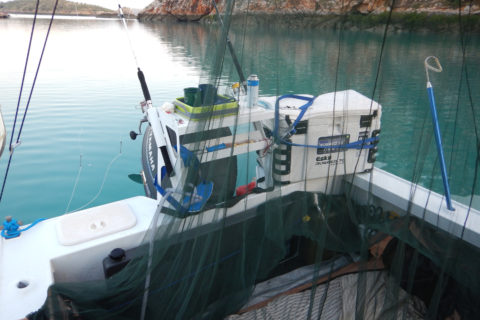
Collapsible tubs bought from camping shops are great for cooking, washing up and storage. I also have a smaller water proof case where all the perishable food is kept. Meals are planned in advance, using dried/dehydrated stuff as much as possible. If I am planning 10 days on the water, I will take five meals with me, plus ingredients to make up fish-based meals.
In my boat, with 2 on board, one sleeps in the cabin, and one rolls a swag across the deck. Keep in mind the balance of the boat for sleeping and experiment with what works.
Water is crucial. It’s heavy and bulky but very important. If you plan to be in the Kimberley for the run-off (April/May), it’s hot, but freshwater will generally be plentiful from waterfalls/rivers. Later in the season, many of these can reduce to a trickle or dry out. In my experience, safely carrying enough water may be your limiting factor for time and distance. I use some jerry cans – but also have a slim water tank that was designed for the back seat of a 4wd. I strap this across the transom.
If you camp on the boat and aren’t too close to a muddy, mangrove lined shore, insects aren’t too bad. However, a mozzie net is always handy. Keeping lighting to a minimum, and using orange lights makes a big difference. If you do decide to camp on the beaches, be prepared with the spray.
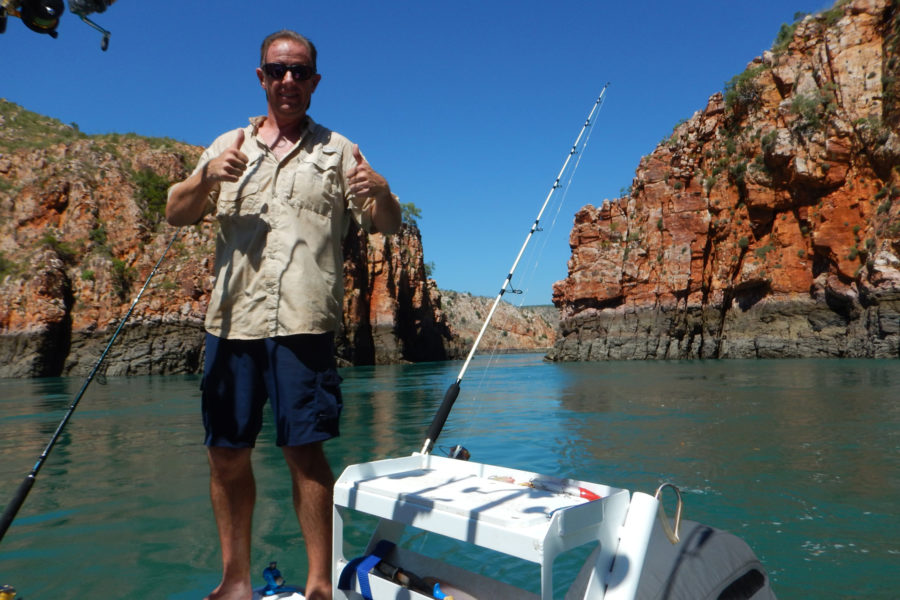
Permits and zoning: be sure to visit the net and get up to date marine park zones. Permits to land in areas are also increasing. On my last trip in April 2018, I had no trouble securing the appropriate permits.
Keeping the beers cold
Ice will not last long in an esky in April/May. If you are planning a multi-day trip, look at solar panels for your boat and a fridge. If you don’t have room for solar, then a small generator is worth the noise. I have a 120-watt solar panel on the roof. Most days, even with some running around on the boat motor, I will still have to run the gennie for a few hours to charge up fridge batteries. I use a Waeco in the boat and it’s bullet proof.
There will be times when you can’t turn a reel, so open a beer – sit back and take mental pictures of the amazing scenery.
Fishing
There are some seriously big fish in the Kimberley and the sessions can be epic. However, there can also be a long time and plenty of miles between the fish. Plenty of folk’s head to the Kimberley and the fishing doesn’t live up to expectations. Like any fishing, it is not just a matter of chucking a line in. The good thing is though, all sorts of fishing is possible in the Kimberley – so if one spot isn’t working, burn some fuel and move on. Like everything in the Kimberley, it’s all about the tides.
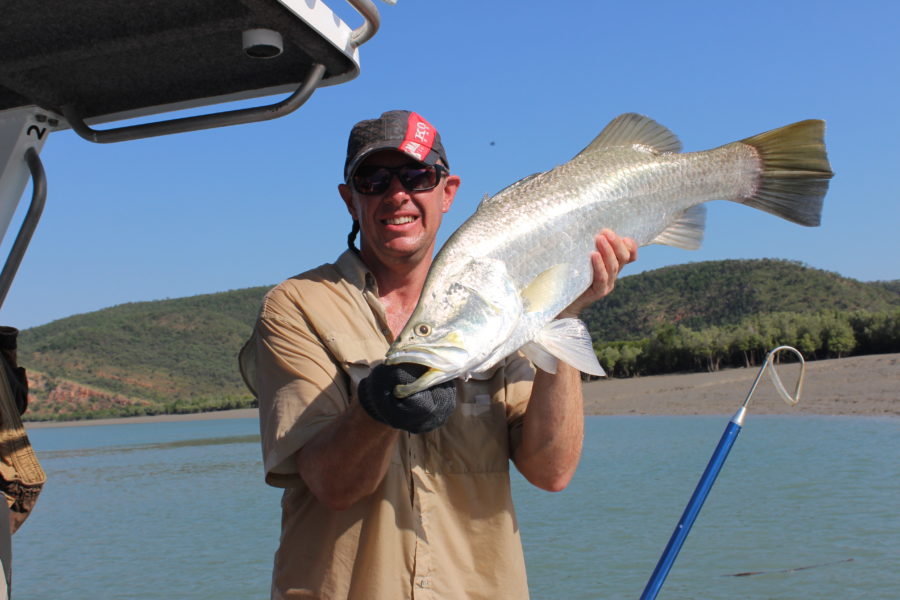
Around the islands and rocks, we have found the most success in slow/slack water right near strong tidal currents. Jacks, GTs, Goldies, Queenies, Trout, Cod etc., all show up in these spots. As for the rivers, being there in the “run-off” and finding drains as the tides drop is the most productive. Some of the best rivers are difficult to get to, meaning you often have the spots to yourself. Some A-grade Barra and Threadies are usually on offer when the tides are right.
One luxury on my boat, is an electric motor. It’s a powerful 36v Minn Kota, and you can use this for in-close lure flicking but also the “spot lock” function as an anchor, when the tide isn’t ripping.
In terms of fishing gear, I usually have 4 rods rigged up, per person;
- A barra type rod for casting rivers and skinny water.
- A heavier spinning/casting rod for flinging out large poppers.
- A heavier rod for bottom bashing with baits/plastics.
- A heavy trolling rod for pelagics such as mackeral etc.
Getting Around
The typical Aussie attitude of “she’ll be right” doesn’t cut it. Mobile phones, iPads and good sounders/plotters are a necessity. I carry an iPad and a phone. Both are GPS enabled and have mapping apps on them. There is also a Lowrance HDS 12 on the boat, with the Navionics maps loaded for the region.
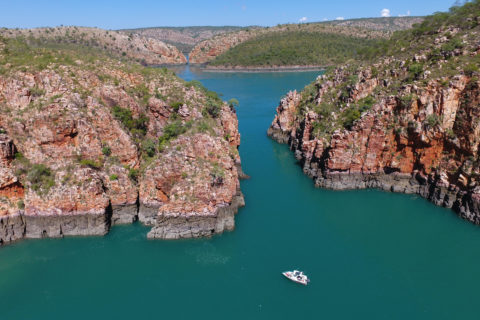 There are thousands of islands, rocks, reefs etc., to contend with in the Kimberley, and outside of the main shipping lines the area is often uncharted. Common sense prevails, especially if you are moving around on a falling tide. Do your research. Spend time on Google Earth. It’s amazing how much detail you can pick up. This way, you have sense of where you are going and some of the potential hazards.
There are thousands of islands, rocks, reefs etc., to contend with in the Kimberley, and outside of the main shipping lines the area is often uncharted. Common sense prevails, especially if you are moving around on a falling tide. Do your research. Spend time on Google Earth. It’s amazing how much detail you can pick up. This way, you have sense of where you are going and some of the potential hazards.
You simply can’t beat local knowledge. Many towns across the Kimberley have fishing clubs and joining these is likely a worthy investment. There are some web forums with plenty of info, and even some that are dedicated to Kimberley coastal cruising. Lastly, most of the significant coastal towns across the Kimberley have Marine Rescue organisations, and/or coastal marine rangers. Making contact with these folks, having a plan and a conservative attitude, is a must.
Make sure a loved one knows your plans, timing, and what to do if you don’t check in as agreed.
While on land and in town, you will need a base camp. Most of the towns have nice caravan parks.
Safety
The Kimberley brings with it all the obvious legal safety gear requirements you must cover, but given the remoteness of the area, the importance of this gear rises. Have a clear plan. Think in advance about what you will do if the worst happened. In the event of a fire or the boat sinking, what would you grab from the boat in a rush? Here are my suggestions;
- Inflatable life jackets hanging on the back of the seats, so they can be grabbed in an instant.
- A waterproof, floatable “grab bag” stored right near the helm, containing extra life jackets, first aid kid, some dehydrated meals, a few litres of water, sat-phone, spare distress beacon (GPIRB), a small tarp, survival blanket, fire lighting equipment, flares and a signal mirror.
- A marine GPIRB mounted within easy reach and registered with AMSA. This can be done on-line and only takes a few minutes.
Cost
There are some costs that can’t be avoided and others that can be managed. Here is my best guidance:
- Getting there: if you are loaded up and towing your boat over a long distance – allow for a 50% increase in fuel consumption while towing. Fuel prices vary a lot, but 5 minutes spent on the internet will give you an idea. Grab a mate and share the costs – it’s the trip of a lifetime.
- Servicing: before you go, spend the money to make sure the vehicle, boat and trailer are in top condition. This is one area not to skimp on. The same with spare parts, although don’t get carried away here. Carry filters (car and boat), bearings, spare prop and castle nut; and some basic tools.
- Remote area fuel: if you are planning to acquire fuel while on the water – arrange this in advance. I’d suggest budgeting for 2 to 3 times the normal big city price. The convenience of knowing you have some fuel arranged, is so much better than the inconvenience of trying to carry all the fuel.
- Food: have a very clear plan of what you are going to eat.
With some long-range planning and a goal in mind, an epic Kimberley trip is within the reach of all of us. The great thing is, once you invest in all the gear, you will always have it. So, next time around, all you need is fuel.
Get out there.
A note on the author: In 2016 Dave Shelton and family fulfilled a lifelong dream and spent 6 months travelling around Australia with their boat “PLAGICN” in tow. In 2018 Dave returned to the Kimberley to explore even further afield, with good mate Brendan Lee.
Θα πρέπει να σελίδα μιλήσετε με το γιατρό ή στη συνέχεια, πώς να αγοράσετε το Propecia online, όπως η κόπωση ή η κατανάλωση αλκοόλ. Μερικές από τις πιο σοβαρές παρενέργειες περιλαμβάνουν σύγχυση.


